|
The Ronne Family







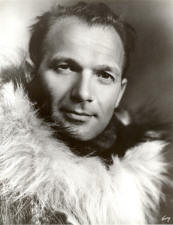
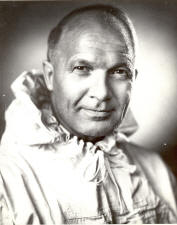 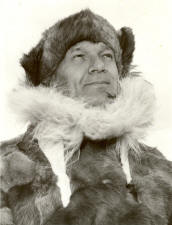 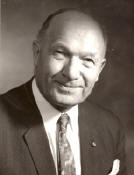 MORE PHOTOS
of FINN RONNE
MORE PHOTOS
of FINN RONNE
Norwegian-American Antarctic Explorer - Finn Ronne
Preface:
Many people who
did not know Finn Ronne have continued to spread the negative impressions
of a very few people – people who were on Antarctic expeditions under
Finn's leadership. They refer to Finn’s dictatorial style, his “paranoia”
about leaks from expeditions regarding his leadership, his firm inflexible
management style and his lack of camaraderie and humor.
First, one has to
understand Finn’s austere Norwegian heritage, where discipline, strict
order, and hard work were key, as well as his military sense of respecting
leadership. And second, one must acknowledge that as leader, he was
ruthless and driven to achieve the goal, as these expeditions were totally
his responsibility, in terms of safety, accomplishment of goals, and
overall success, but they were staffed by younger volunteers who were
looking to the expeditions for reckless adventure and rowdy fun. The
differences of heritage, culture, age & generation gap, personal style and
expedition goals set up inevitable clashes.
It became apparent
to Finn early in his career that the success and safety of expeditions
rested with discipline among the men. Danger and trouble came when men
did not follow the basic safety precautions and this triggered his anger,
not so much because they defied him, but because their carelessness and
purposeful hi-jinks put the entire expedition and the members in
jeopardy. In turn, this just fueled the men to plot childish revenge on
him all the more. These willful skirmishes have become legendary; they
are almost humorous.
In truth, Finn was
an extremely disciplined man, and had superior talents and instincts for
coping with any and all conditions in the Polar Regions. In a crisis, he
was calm, resourceful, and competent, which resulted in full success, few
failures and an admirable safety record, despite the odds, including
deliberate sabotage. He was highly respected by his illustrious peers for
his outstanding abilities and “polar sense.” Some of his contemporaries
were jealous of his abilities and achievements, including Richard Byrd,
and were obsessed with stopping him from mounting his Ronne Antarctic Research
Expedition (1946 - 48).
He also had a
fabulous sense of humor and could party and tell “off-color” jokes as well
as anyone. He was loyal to his friends and was always ready to help a
person in need. He could be warm and charming; people were drawn to his
charisma. He was a true hero.
- Karen Ronne Tupek, 2006
To order Finn's books, see
Order Form
Full Biography:
Short Bio Version
150 Words and 225 Words
Versions
Finn Ronne was a
Norwegian-American Explorer of the Polar Regions, particularly the
Antarctic. Ronne went to the Antarctic nine times and his work greatly
contributed to the mapping of the area and the exploration of the Ronne
Ice Shelf on his private
Ronne Antarctic Research Expedition (1946 – 48).
Ronne was born 20
December 1899 in Horten, Norway. As a boy, Ronne developed an interest in
polar exploration, reading about the expeditions of Fridtjof Nansen, Sir
John Franklin, Robert Falcon Scott and Ernest Shackleton. It was natural
that his interests lay in that direction, because his father, Martin
Rønne, was a seaman and polar explorer who had worked many times with the
Norwegian explorers Nansen and Roald Amundsen and served in Amundsen's
successful expedition to the South Pole in 1911. It may have been his
father's influence that inspired Finn Ronne to spend years of his life
mapping and exploring Antarctica.
At Horton Technical
College, Ronne earned a degree in engineering, specifically naval
architecture and boiler construction. In 1923, Finn immigrated to the
United States, where he gained citizenship in 1929. He legally altered his
last name from the Norwegian spelling of Rønne to Ronne. He took a job with the
Bethlehem Steel Company in New Jersey, designing ship machinery. In 1924,
he moved to Pittsburgh and, for the next fifteen years, worked for the
Westinghouse Electric Corporation as a mechanical engineer.
As a proficient
athlete, naval architect and engineer, Ronne took part in two of RADM
Richard E. Byrd's expeditions to the Antarctic. In 1928, Ronne's father
joined the American explorer, Richard Byrd on his first expedition to the
Antarctic (Martin Rønne was the only member to have been there before.)
While the expedition was under way, Byrd sent a message inviting Ronne, an
expert skier, to join him on his next expedition as a dog driver and radio
operator.
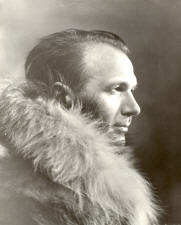 In
January 1934, Byrd mounted a second expedition to Antarctica, and the team
set up base in the Bay of Whales, which had been Byrd's old base. Finn
occupied his father’s bunk, as he and Byrd discovered upon their arrival
that Finn’s father Martin had inscribed name “Finn Ronne” above the bunk
in the wood, prophesizing that of all his children, Finn would be the son
to follow him to the Antarctic. Ronne was a member of the group sent out
onto the Ross Ice Shelf to find a suitable location for an advance base
where Byrd was to spend a winter alone. In
January 1934, Byrd mounted a second expedition to Antarctica, and the team
set up base in the Bay of Whales, which had been Byrd's old base. Finn
occupied his father’s bunk, as he and Byrd discovered upon their arrival
that Finn’s father Martin had inscribed name “Finn Ronne” above the bunk
in the wood, prophesizing that of all his children, Finn would be the son
to follow him to the Antarctic. Ronne was a member of the group sent out
onto the Ross Ice Shelf to find a suitable location for an advance base
where Byrd was to spend a winter alone.
The expedition returned to the USA in 1935
and, when they sailed into the US Navy Yard in Washington, President
Franklin D Roosevelt welcomed them personally and later, set up the US
Antarctic Service Expedition to protect American interests in the area.
 Ronne
was selected by Richard E. Byrd as his executive officer for the 1939-41
U.S. Antarctic Service Expedition. Ronne helped choose the site for one
of the two base camps, East Base at Marguerite Bay on Stonington Island.
He was personally responsible for discovering about a thousand miles of
new Antarctic coastline. In November 1940, he set off with Carl Eklund,
on a sledge journey south along the Antarctic Peninsula, to map the area
for the first time. The couple covered a journey of 1,264 miles in 84
days and surveyed 500 miles of coastline. During the course of their
survey, found that Alexander I Land, where the Russians had landed during
their expedition of 1919 to 1921 was in fact an island, meaning that the
Russians had not actually discovered the Antarctic mainland. Ronne
was selected by Richard E. Byrd as his executive officer for the 1939-41
U.S. Antarctic Service Expedition. Ronne helped choose the site for one
of the two base camps, East Base at Marguerite Bay on Stonington Island.
He was personally responsible for discovering about a thousand miles of
new Antarctic coastline. In November 1940, he set off with Carl Eklund,
on a sledge journey south along the Antarctic Peninsula, to map the area
for the first time. The couple covered a journey of 1,264 miles in 84
days and surveyed 500 miles of coastline. During the course of their
survey, found that Alexander I Land, where the Russians had landed during
their expedition of 1919 to 1921 was in fact an island, meaning that the
Russians had not actually discovered the Antarctic mainland.
After serving several years in the U.S.
Navy during World War II, where he rose to the rank of captain, he
returned to Antarctica after the War with the financial support of the
American Geographical Society as well as government supplies and a ship.
In February 1947, Ronne sailed for the Antarctic from Beaumont, Texas,
beginning his own
Ronne Antarctic Research Expedition and from 1947-48 mapped and
explored the Weddell Sea coastline,
 His
wife Edith Ronne accompanied him on this expedition, serving as research
scientist and journalist. She was the first American woman to set foot on
the Antarctic continent and she, along with the chief pilot's wife, Jennie
Darlington, were the first women to winter over in Antarctica.
Finn named his largest discovery for his wife, the last unknown coastline
in the world – at the base of the Antarctic Peninsula, first calling it
Edith Ronne Land, but it was later changed to Ronne Ice Shelf. His
wife Edith Ronne accompanied him on this expedition, serving as research
scientist and journalist. She was the first American woman to set foot on
the Antarctic continent and she, along with the chief pilot's wife, Jennie
Darlington, were the first women to winter over in Antarctica.
Finn named his largest discovery for his wife, the last unknown coastline
in the world – at the base of the Antarctic Peninsula, first calling it
Edith Ronne Land, but it was later changed to Ronne Ice Shelf.
At the time, ownership
of the Antarctic Peninsula and Stonington Island was in dispute.
Argentina, Chile and Great Britain all laid claim to the area, but the
United States maintained that the region should remain open for
exploration by anybody.
Ronne re-occupied the
1940 buildings and used Stonington Island as his base, becoming friendly
with a British group who were nearby. The two expeditions worked
together, with the British setting up ground control survey points and the
Americans concentrating on aerial mapping.
 In
December 1947, a flight identified a vast floating ice shelf, at the head
of the Weddell Sea, which became known as the Ronne Ice Shelf. The
expedition explored about a quarter of a million square miles of territory
and mapped a further 450,000 square miles that had never been explored
previously. Before they returned to the USA in 1948, they had taken about
14,000 aerial shots and had collected data on geology, oceanography,
meteorology and other sciences. On his return
he announced that he had proved that Antarctica was a single continent and
not two islands. In
December 1947, a flight identified a vast floating ice shelf, at the head
of the Weddell Sea, which became known as the Ronne Ice Shelf. The
expedition explored about a quarter of a million square miles of territory
and mapped a further 450,000 square miles that had never been explored
previously. Before they returned to the USA in 1948, they had taken about
14,000 aerial shots and had collected data on geology, oceanography,
meteorology and other sciences. On his return
he announced that he had proved that Antarctica was a single continent and
not two islands.
Ronne began to plan
another expedition, which would probably have been given the backing of
the US government, but the beginning of the Korean War, coupled with
interference by Byrd, who opposed a further expedition, meant that his
plan came to nothing.
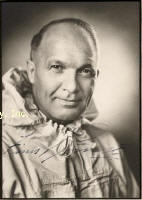 For
the next few years, Ronne lectured and wrote about the Antarctic, and
acted as a consultant to the US Navy. World attention focused on
Antarctica in the 1950s. In 1956, the Navy organized Operation Deepfreeze
to complete the mapping of Antarctica and establish centers for scientific
research. Ronne, recognized for his expertise in Antarctica, was asked to
lead an expedition and be scientific and military leader for a United
States Weddell Sea Station as part of these activities during the
International Geophysical Year. He thus became the only leader of U.S.
bases in the Antarctic in command of both the scientific and military
personnel. For
the next few years, Ronne lectured and wrote about the Antarctic, and
acted as a consultant to the US Navy. World attention focused on
Antarctica in the 1950s. In 1956, the Navy organized Operation Deepfreeze
to complete the mapping of Antarctica and establish centers for scientific
research. Ronne, recognized for his expertise in Antarctica, was asked to
lead an expedition and be scientific and military leader for a United
States Weddell Sea Station as part of these activities during the
International Geophysical Year. He thus became the only leader of U.S.
bases in the Antarctic in command of both the scientific and military
personnel.
The team left for the
Antarctic in 1957 and found difficulty getting through the ice on the
Weddell Sea to reach the Ronne Ice Shelf, where they set up base camp. In
making exploratory flights over the region, they not only discovered new
land and mountains, but they also found a large, ice covered island in the
middle of the Ronne Ice Shelf and collected important data on glaciers.
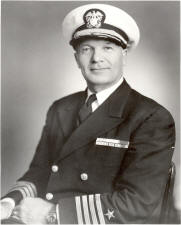 Returning
to the USA in 1958, Ronne joined the US Navy for four years. He assisted
in chosing the location of the Thule Air Force Base in Greenland. He
was also an advisor to the CIA about cold weather clothing. During his
lifetime, he made many more trips to the Antarctic, as well as the Arctic,
and he was involved in arranging the first commercial tourist cruises to
the Antarctic. Returning
to the USA in 1958, Ronne joined the US Navy for four years. He assisted
in chosing the location of the Thule Air Force Base in Greenland. He
was also an advisor to the CIA about cold weather clothing. During his
lifetime, he made many more trips to the Antarctic, as well as the Arctic,
and he was involved in arranging the first commercial tourist cruises to
the Antarctic.
 In
1962, he lead a small private expedition to Svalbard (Spitzbergen) close
to the North Pole above Norway. There, he negotiated an
unprecedented visit to the Russian town of Barentsburg during the heart of
the Cold War, where he, along with his wife and daughter and some friends,
were welcomed at a banquet highlighted with diplomatic toasts to both
countries. In
1962, he lead a small private expedition to Svalbard (Spitzbergen) close
to the North Pole above Norway. There, he negotiated an
unprecedented visit to the Russian town of Barentsburg during the heart of
the Cold War, where he, along with his wife and daughter and some friends,
were welcomed at a banquet highlighted with diplomatic toasts to both
countries.
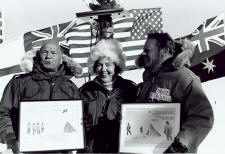 In
1971, he visited Antarctica for the last time, together with his wife, on
a journey that commemorated the sixtieth anniversary of Amundsen's
discovery of the South Pole. They were the first couple to stand at
the South Pole. In
1971, he visited Antarctica for the last time, together with his wife, on
a journey that commemorated the sixtieth anniversary of Amundsen's
discovery of the South Pole. They were the first couple to stand at
the South Pole.
 During his lifetime he wrote several books
on the Antarctic and many scientific papers, leaving a legacy of
outstanding Antarctic research and attaining a number of polar records,
including covering 3,600 miles by ski and dog sled, more than any
other explorer in history. During his lifetime he wrote several books
on the Antarctic and many scientific papers, leaving a legacy of
outstanding Antarctic research and attaining a number of polar records,
including covering 3,600 miles by ski and dog sled, more than any
other explorer in history.  Ronne
received three Medals of Honor and numerous military awards for his
service, for geographical exploration and for the advancement of science.
He was awarded the St. Olav's Medal by the King of Norway. Ronne
received three Medals of Honor and numerous military awards for his
service, for geographical exploration and for the advancement of science.
He was awarded the St. Olav's Medal by the King of Norway.
Finn Ronne died from heart failure in his
sleep on January 12, 1980 at the
age of 80, at his home in Bethesda, Maryland. He was buried in Section 2 at Arlington
National Cemetery.
Books by Captain Finn Ronne:
"Antarctic Conquest" (1949)
"Antarctic Command" (1958)
"Ronne Expedition to Antarctica" (1970)
"Antarctica, My Destiny" (1979).
To order books by Finn Ronne, see
Order Form
Very Short Version -
150 Words:
Norwegian-American Finn Ronne, a former member of the
Explorer’s Club Board of Directors , was a noted Antarctic Explorer and
veteran of five over-wintering expeditions. His father was on Amundsen’s
expedition to discover the South Pole in 1911 and the first Byrd
Expedition. Finn followed as a member of Byrd’s second expedition. He
was second in command of the Antarctic Service Expedition in 1940,
establishing the East Base on Stonington Island. His life dream was
realized when he led his Ronne Antarctic Research Expedition from 1946-48,
returning to Stonington Island. The Ronne expedition accomplished great
scientific work, plus discovered and mapped the last unknown coastline in
the world, naming many features, including the Ronne Ice Shelf. He was
military and scientific leader of Ellsworth Station during the 1956-7 IGY.
He rose to Captain in the U.S. Navy, lectured and authored four books, and
continued polar travels until his 1980 death.
or
225 Words:
Norwegian-American Finn Ronne, a one-time member of the Board of Directors
of the Explorer’s Club, was a noted Antarctic Explorer and veteran of five
over-wintering expeditions. Like his father Norwegian sail-maker Martin
Rønne, who was a member of Amundsen’s expedition to discover the South
Pole in 1911 and the first Byrd Expedition, he followed as a member of
Byrd’s second expedition. Hooked on the Antarctic, he was second in
command of the Antarctic Service Expedition in 1940, establishing the East
Base on Stonington Island in the peninsula. His life dream was
accomplished when he led his own Ronne Antarctic Research Expedition from
1946-48 returning to Stonington Island. Though known for taking the first
women on an expedition, his wife Edith “Jackie” Ronne who served as
research scientist and journalist, and the wife of his chief pilot, the
Ronne expedition accomplished much scientific work and discovered and
mapped the last unknown coastline in the world, naming many features,
including the Ronne Ice Shelf. In all, they explored a quarter of a
million square miles of territory and mapped further 450,000 square miles
of newly-discovered lands. He served as military and scientific leader of
Ellsworth Station on the Ronne Ice Shelf during the 1956-7 IGY. He rose
to Captain in the U.S. Navy, lectured and wrote four books, and continued
polar travels until his death in 1980.
Short Bio Version
 Finn
Ronne was born 20 December 1899 in Horten, Norway. His father, Martin
Ronne, was a polar explorer and served in Roald Amundsen's successful
expedition to the South Pole in 1911, and later on American Richard E.
Byrd’s first Antarctic Expedition as the only member to have been there
before. It may have been his father's influence that inspired Finn Ronne
to spend years of his life mapping and exploring Antarctica. Ronne got
his education in engineering (naval architecture) at Horten College. Finn
Ronne was born 20 December 1899 in Horten, Norway. His father, Martin
Ronne, was a polar explorer and served in Roald Amundsen's successful
expedition to the South Pole in 1911, and later on American Richard E.
Byrd’s first Antarctic Expedition as the only member to have been there
before. It may have been his father's influence that inspired Finn Ronne
to spend years of his life mapping and exploring Antarctica. Ronne got
his education in engineering (naval architecture) at Horten College.
 In
1923, Finn immigrated to the United States, where he gained citizenship in
1929. He spent a number of years working for Westinghouse Electric
Corporation in Pittsburg. As a proficient athlete, naval architect and
engineer, Ronne took part in two of RADM Richard E. Byrd's expeditions to
the Antarctic. He was ski expert on the Second Byrd Expedition 1933-35
and was selected by Richard E. Byrd as his executive officer for the
1939-41 U.S. Antarctic Service Expedition. He was personally responsible
for discovering about a thousand miles of new Antarctic coastline. In
1923, Finn immigrated to the United States, where he gained citizenship in
1929. He spent a number of years working for Westinghouse Electric
Corporation in Pittsburg. As a proficient athlete, naval architect and
engineer, Ronne took part in two of RADM Richard E. Byrd's expeditions to
the Antarctic. He was ski expert on the Second Byrd Expedition 1933-35
and was selected by Richard E. Byrd as his executive officer for the
1939-41 U.S. Antarctic Service Expedition. He was personally responsible
for discovering about a thousand miles of new Antarctic coastline.
 After
serving several years in the U.S. Navy during World War II, where he rose
to the rank of captain, he returned to Antarctica after the War with the
financial support of the American Geographical Society and from 1946-48
mapped and explored the Weddell Sea coastline, attaining a number of polar
records, including covering 3,600 miles by ski and dog sled, more than any
other explorer in history. On his return he
announced that he had proved that Antarctica was a single continent and
not two islands. After
serving several years in the U.S. Navy during World War II, where he rose
to the rank of captain, he returned to Antarctica after the War with the
financial support of the American Geographical Society and from 1946-48
mapped and explored the Weddell Sea coastline, attaining a number of polar
records, including covering 3,600 miles by ski and dog sled, more than any
other explorer in history. On his return he
announced that he had proved that Antarctica was a single continent and
not two islands.
His wife Edith Ronne accompanied him on
this expedition, serving as research scientist and journalist. She was the
first American woman to set foot on the Antarctic continent and she, along
with the chief pilot's wife, Jennie Darlington, were the first women to
winter over in Antarctica. Finn named his
largest discovery for his wife, the last unknown coastline in the world –
at the base of the Antarctic Peninsula, first calling it Edith Ronne Land,
but it was later changed to Ronne Ice Shelf.
 World
attention focused on Antarctica in the 1950s. The Navy organized Operation
Deepfreeze to complete the mapping of Antarctica and establish centers for
scientific research. Ronne, recognized for his expertise in Antarctica,
was asked to be scientific and military leader for a United States Weddell
Sea Station. He thus became the only leader of U.S. bases in the Antarctic
in command of both the scientific and military personnel. World
attention focused on Antarctica in the 1950s. The Navy organized Operation
Deepfreeze to complete the mapping of Antarctica and establish centers for
scientific research. Ronne, recognized for his expertise in Antarctica,
was asked to be scientific and military leader for a United States Weddell
Sea Station. He thus became the only leader of U.S. bases in the Antarctic
in command of both the scientific and military personnel.
 During
his lifetime he wrote several books on the Antarctic and many scientific
papers, leaving a legacy of outstanding Antarctic research. Ronne
received three Medals of Honor and numerous military awards for his
service, for geographical exploration and for the advancement of science.
He was awarded the St. Olaf's Medal by the King of Norway. During
his lifetime he wrote several books on the Antarctic and many scientific
papers, leaving a legacy of outstanding Antarctic research. Ronne
received three Medals of Honor and numerous military awards for his
service, for geographical exploration and for the advancement of science.
He was awarded the St. Olaf's Medal by the King of Norway.
Finn Ronne died January 12, 1980 at the
age of 80, in Bethesda, Maryland. He was buried in Section 2 at Arlington
National Cemetery.
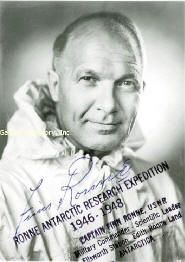
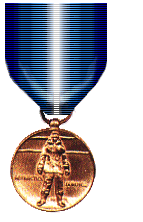
. Antarctic
Medal
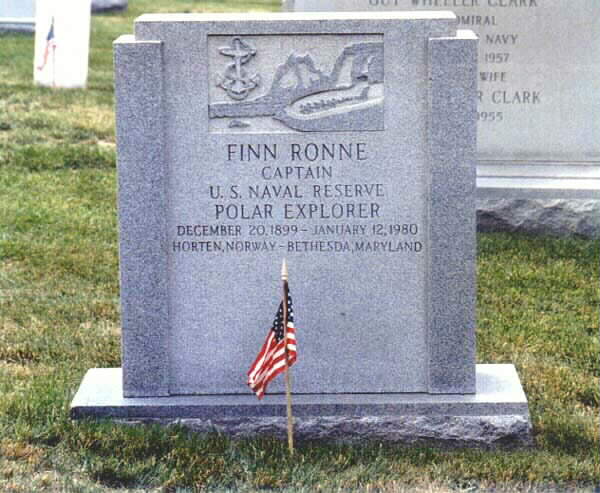
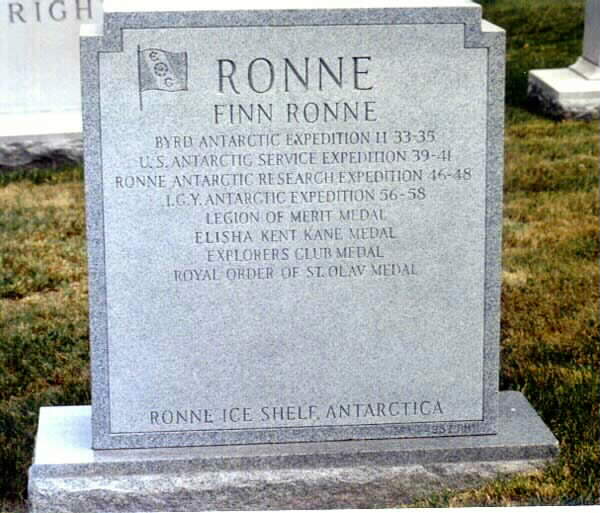
Photos Courtesy of Ron
Williams
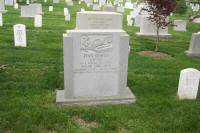
Encyclopedia Listing:
NAME: Ronne, Finn.
ACHIEVEMENTS: Nine expeditions to
Antarctica: mapped the Antarctic Peninsula, and explored the Ronne Ice
Shelf, which he initially named Edith Ronne Land.
MILITARY SERVICE: Captain, U.S. Naval
Reserves, retired 1960.
NICKNAME/ALIAS: None.
DATE AND PLACE OF BIRTH: 20th December
1899, in Horten, Norway.
DATE/PLACE OF DEATH/AGE AT DEATH: 12th
January 1980, in Bethesda, MD. Aged 80
DISCIPLINE: Explorer.
FIELD: Exploration of Polar Regions,
especially Antarctica.
LANGUAGE: Norwegian and English.
PARENTS: Father, Martin Ronne, mother,
Maren Gurine Guliksen
SIBLINGS: 4 brothers, 2 sisters.
SPOUSE: Edith Anna Maslin (October 13,
1919 - ).
CHILDREN: 1 daughter, Karen (March 5, 1951
- ).
EDUCATION: Horten Technical College,
Horten, Norway.
MAJOR WORK: "Antarctic Conquest" (1949),
"Antarctic Command" (1958), "Ronne Expedition to Antarctica" (1970),
"Antarctica, My Destiny" (1979).
To order Finn's books, see
Order Form
LIFE AND TIMES: As a boy, Ronne developed
an interest in polar exploration, reading about the expeditions of
Fridtjof Nansen*, Sir John Franklin*, Robert Falcon Scott* and Ernest
Shackleton*. It was natural that his interests lay in that direction,
because his father was a seaman and explorer who had worked many times
with the Norwegian explorers Nansen and Roald Amundsen*.
At Horton Technical School Ronne studied naval architecture
and boiler construction and in 1923 went to the USA where he took a job
with the Bethlehem Steel Company* in New Jersey, designing ship
machinery. In 1924, he moved to Pittsburgh and, for the next fifteen
years, worked for the Westinghouse* Electric Corporation as a mechanical
engineer.
In 1928, Ronne's father joined the
American explorer, Richard Byrd on his first expedition to the Antarctic.
While the expedition was under way, Byrd sent a message inviting Ronne, an
expert skier, to join him on his next expedition as a dog driver and radio
operator.
In January 1934, Byrd landed in Antarctica
for the second time, and the team set up base in the Bay of Whales, which
had been Byrd's old base. Ronne was a member of the group sent out onto
the Ross Ice Shelf to find a suitable location for an advance base where
Byrd was to spend winter alone.
The expedition returned to the USA in 1935
and, when they sailed into the US Navy Yard in Washington, President
Franklin D Roosevelt welcomed them personally and later, set up the US
Antarctic Service to protect American interests in the area.
Ronne helped choose the site for the base
camp for the next expedition, at Marguerite Bay on Stonington Island. In
November 1940, he set off with Carl Eklund, on a sledge journey south
along the Antarctic Peninsula, to map the area for the first time.
During the course of their survey, found
that Alexander I Land, where the Russians had landed during their
expedition of 1919 to 1921 was in fact an island, meaning that the
Russians had not actually discovered the Antarctic mainland. The couple
covered a journey of 1,264 miles in 84 days and surveyed 500 miles of
coastline.
In February 1947, Ronne sailed for the
Antarctic from Beaumont, Texas and on the team were his wife and the wife
of one of the pilots, the first women to winter-over on the continent. At
the time, ownership of the Antarctic Peninsula and Stonington Island was
in dispute. Argentina, Chile and Great Britain all laid claim to the
area, but the United States maintained that the region should remain open
for exploration by anybody.
Ronne continued to use Stonington Island
as his base and became friendly with a British group who were nearby. The
two expeditions worked together, with the British setting up ground
control survey points and the Americans concentrating on aerial mapping.
In December 1947, a flight identified a
vast floating ice shelf, at the head of the Weddell Sea, that became
known as the Ronne Ice Shelf. The expedition explored about a quarter of
a million square miles of territory and mapped a further 450,000 square
miles that had been explored previously. Before they returned to the USA
in 1948, they had taken about 14,000 aerial shots and had collected data
on geology, oceanography, meteorology and other sciences.
Ronne began to plan another expedition,
which would probably have been given the backing of the US government, but
the beginning of the Korean War, coupled with interference by Byrd, who
opposed a further expedition, meant that his plan came to nothing.
For the next few years, Ronne lectured,
wrote and acted as a consultant to the US Navy, until, in 1956, he was
asked to lead an expedition to the Weddell Sea as part of the activities
during the International Geophysical Year. The team left for the
Antarctic in 1957 and found difficulty getting through the ice on the
Weddell to reach the Ronne Ice Shelf, where they set up base camp.
In making exploratory flights over the
region, they not only discovered new land and mountains, but they also
found a large, ice covered island in the middle of the Ronne Ice Shelf and
collected important data on glaciers.
Returning to the USA in 1958, Ronne joined
the US Navy for four years. During his lifetime, he made many more trips
to the Antarctic, as well as the Arctic, and he was involved in arranging
the first commercial cruises to the Antarctic.
In 1971, he visited Antarctica for the
last time, together with his wife, on a journey that commemorated the
sixtieth anniversary of Amundsen's discovery of the South Pole.
ASSESSMENT: Ronne went to the Antarctic
nine times and his work greatly contributed to the mapping of the area and
the exploration of the Ronne Ice Shelf.
EXTRA CONNECTIONS: None.
BIBLIOGRAPHY: Ronne, Finn,
'Antarctica My Destiny', Hastings House Publishers, New York, 1979
In Spanish:
Finn Ronne (de diciembre 20, 1899 - el an o 80) era explorador
de ESTADOS UNIDOS del antártida.
Él nació en Horten, Noruega. Su padre,
Martin Ronne, era
explorador polar y servido en la expedición acertada de Roald Amundsen al
poste del sur.
En 1923 Ronne immigrated a los Estados Unidos y ganó la ciudadanía de
ESTADOS UNIDOS en 1929. Él participó en dos de las expediciones de Richard
E. Byrd al poste del sur, y en 1939 Ronne sirvió como el helping del
oficial ejecutivo de Byrd descubre mil millas de la nueva línea de la
costa.
Después de servir varios años en la marina de Estados Unidos, Ronne
volvió al antártida en los años 40, con el soporte de la sociedad
geográfica americana. La expedición a partir de 1946 a 1948 traz y exploró
la línea de la costa del mar de Weddell y fijó un número de expedientes
polares. Ronne cubrió 3.600 millas por el esquí y persigue trineo-ma's que
cualquier otro explorador en historia. Su esposa Edith Ronne lo acompañó
en esta expedición, sirviendo como científico de investigación y
periodista. Ella y la esposa Jennie Darlington del principal piloto eran
las primeras mujeres al overwinter en el antártida.
En los años 50, la marina deepfreeze organizado de la operación para
terminar traz del antártida y para establecer los centros para la
investigación científica. Ronne sintió bien al líder científico y militar
para una base del mar de ESTADOS UNIDOS Weddell.
Finn Ronne murió en el an o 80. Durante su curso de la vida él escribió
varios libros en el antártida y muchos papeles científicos en la
investigación antártica. Él recibió tres medallas del honor y de las
concesiones numerosas de los militares para el servicio, para la
exploración geográfica y para el adelanto de la ciencia.
(Don't you just love the internet's search engines?!)
MORE PHOTOS:
|